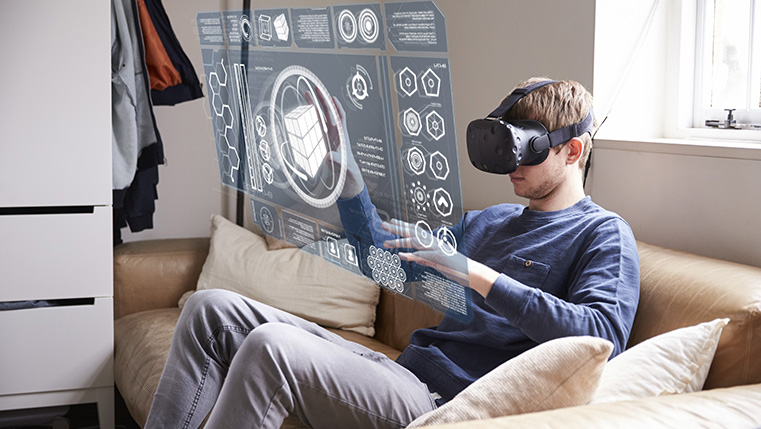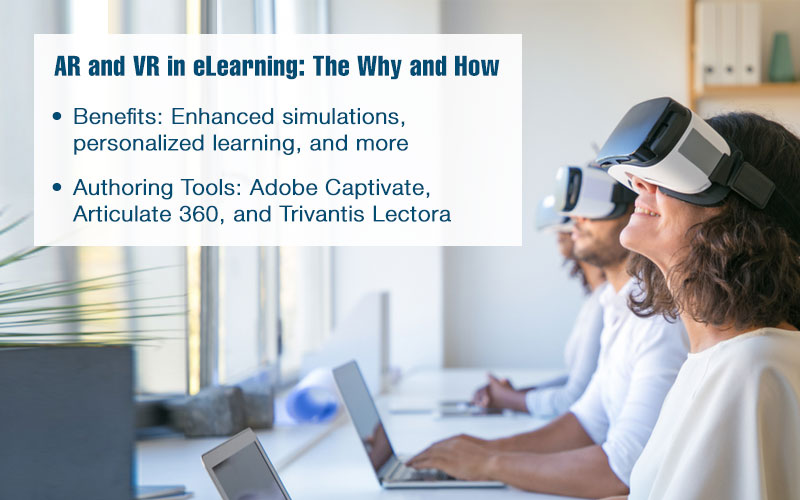Nowadays, it has become increasingly difficult for employees to attend their training in person. However, many employees are eager to acquire new skills, and as a result their training has become more important than ever, and it may become even more so as they return to their pandemic adjusted workplaces. How do companies deal with the increasing demand for training? By leveraging the power of new technologies such as VR.
Virtual Realityhas shown to be one of the most effective methods of implementing employee training, and it is here to stay! It has already been incorporated into corporate skills training, such as simulating unknown terrain for soldiers in the US. It VR has also made significant progress in the aviation and entertainment industries. Of late, VR has captured the attention of theL&Dcommunity, as it has a lot of potential. Let’s explore more about how VR can make a lasting impact on the eLearning industry.
What are the Practical Applications of VR in eLearning?
Some of the Practical Applications of VR in eLearning are:
- Dynamic and Secure Platform
- 先进的学习分析
- Gamification
- Powerful Assessment Strategies
What is VR?
- VR is a computer-generated environment that reflects the world we live in as well as creates new, fantasy worlds to explore.
- VR offers you totally immersive experiences that can separate you from the outside world. To put it another way, VR creates its own world that can be used to mirror reality.
- A couple of examples of implementing VR is in the medical and military fields.
- It makes use of headsets with stereo sound and motion-tracking sensors. Oculus Quest, HTC Vive, and Google Cardboard are a few headsets that you can use for the best clarity and experience.
Explore how rapid eLearning can help with quick rollout, whether it’s immersive learning or game-based courses.
VR in eLearning
Learners are much less distracted when immersed in VR. You can captivate you learners’ attention and keep them glued to their screens as they experiencesimulationsand many other virtual encounters on a VR headset. In contrast to conventional eLearning, VR takes the learner into an imagined environment, shutting them out from the real world. When learners are immersed in VR, they are likely to retain more information and achieve better results.
Here are a few statistics from research conducted byPricewaterhouseCoopers:
- Learners are 2x as confident in applying skills gained from training in VR than when they are attending conventional eLearning courses
- VR eLearning courses are 4x faster than classroom training
- VR learners are 3x more invested in their learning than classroom learners.
Learners can use all their five senses to engage in learning programs that incorporates VR. NASA, for example, uses VR to prepare astronauts for future space expeditions.
Imagine astronauts being able to virtually explore outer space. They would be able to discover items virtually as they would when actually flying through outer space. This allows the astronauts to refine their skills and make the most of their training.
VR offers the potential to improve eLearning and build dynamic learning modules. You would be able to integrate 3D visuals and real-life experiences to create unique and exciting courses. VR enables “learning by doing”, immersing learners in an imagined world, and shutting them out from the real world. VR uses technology that can take your eLearning courses to new heights. Let’s investigate some of its benefits.
What are the Practical Applications of VR in eLearning?
1. Dynamic and Secure Platform
The goal of virtual reality is to completely captivate your learners in an imagined environment. You can block out distractions by using audio devices and headsets and focus on the activity at hand. Learners can interact with virtual components of real-life counterparts. For instance, you can provide your employees with hands-on experiences tackling challenging scenarios such ashealth and safetyprocedures to reduce workplace accidents and injuries.
Another example is when you want to train surgeons to perform uncommon and infrequent procedures. Surgeons can concentrate without the fear of failure or the fear of harming themselves and others when practicing in VR. They can assess their abilities before attempting them in real life.
2.综合Learning Analytics
VR offers you sophisticated learning analytics. You can track your learners’ using voice recognition and analysis, body position and movement, biometric feedback, and retinal eye tracking to assess their engagement.
These insights empowered by VR can then be used to improve your course and make it easy to use. VR offers unparalleled access to data on your learner’s vis-a-vis built-in tracking in their headsets, that can be studied on the VR analytics platform. Individually as well as across large audiences, VR data can be utilized to demonstrate training efficacy and recommend areas for improvement.
3. Gamification
With practically every industry adopting it,gamificationis trending in the digital world, you can give amazing and extremely realistic real-life experiences to your learners through VR enabled gamification. Through VR, you can offer your learners riddles, adventures, role-plays, strategies, interactions, and simulations immersing them in a variety of environments. Learners can put on their VR headsets and hold their rewards, points and badges using their virtual bodies, all thanks to VR.
You can develop highly dynamicgame-basedcourses in which your learners can learn through play. By assigning tasks to your learners and allowing them to choose how they will proceed, you offer your learners fun and exciting ways to engage in their training.
4. Assessments in eLearning using Visual Feedback
VR empowers you to usebranching scenarios, online simulations, and other types of eLearning assessments to help you improve your evaluation methodologies. VR enables you to record and monitor your learners’ performance.
Parting Thoughts
Our lives have been thrown into chaos because of the pandemic. Now, more than ever, organizations are demanding innovative eLearning courses. As a result, now is the best time to invest in VR empowered learning experiences to benefit your employees and your business.
Although implementing VR is expensive and it restricts your learners’ mobility, tying them down to a specific learning environment, it produces better training outcomes and is a win-win for employees and employers alike. VR is gaining traction, and it is projected that the market will explode with VR in the near future.
Are you aware of other trends in eLearning, apart from VR, that are dominating today’s market? If you want to explore the latest e-learning trends, check out our eBook on “eLearning Trends to determine how engaged they were with the training.’’






![New Age Corporate Training with AR and VR in eLearning [Infographic]](http://www.vine9.com/wp-content/uploads/2020/08/ar-vr-elearning-advantages-disadvantages-infographic.jpg)